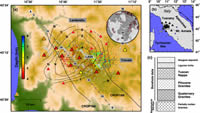Discovering geothermal supercritical fluids: a new frontier for seismic exploration
Piana Agostinetti N., A. Licciardi, D. Piccinini, F. Mazzarini, G. Musumeci, G. Saccorotti & C. Chiarabba (2017).
Nature, Scientific Reports 7, Article number: 14592 (2017), doi:10.1038/s41598-017-15118-w.
Abstract
Exploiting supercritical geothermal resources represents a frontier for the next generation of geothermal electrical power plant, as the heat capacity of supercritical fluids (SCF),which directly impacts on energy production, is much higher than that of fluids at subcritical conditions. Reconnaissance and location of intensively permeable and productive horizons at depth is the present limit for the development of SCF geothermal plants. We use, for the first time, teleseismic converted waves (i.e. receiver function) for discovering those horizons in the crust. Thanks to the capability of receiver function to map buried anisotropic materials, the SCF-bearing horizon is seen as the 4km-depth abrupt termination of a shallow, thick, ultra-high (>30%) anisotropic rock volume, in the center of the Larderello geothermal field. The SCF-bearing horizon develops within the granites of the geothermal field, bounding at depth the vapor-filled heavily-fractured rock matrix that hosts the shallow steam-dominated geothermal reservoirs. The sharp termination at depth of the anisotropic behavior of granites, coinciding with a 2 km-thick stripe of seismicity and diffuse fracturing, points out the sudden change in compressibility of the fluid filling the fractures and is a key-evidence of deep fluids that locally traversed the supercritical conditions. The presence of SCF and fracture permeability in nominally ductile granitic rocks open new scenarios for the understanding of magmatic systems and for geothermal exploitation.


